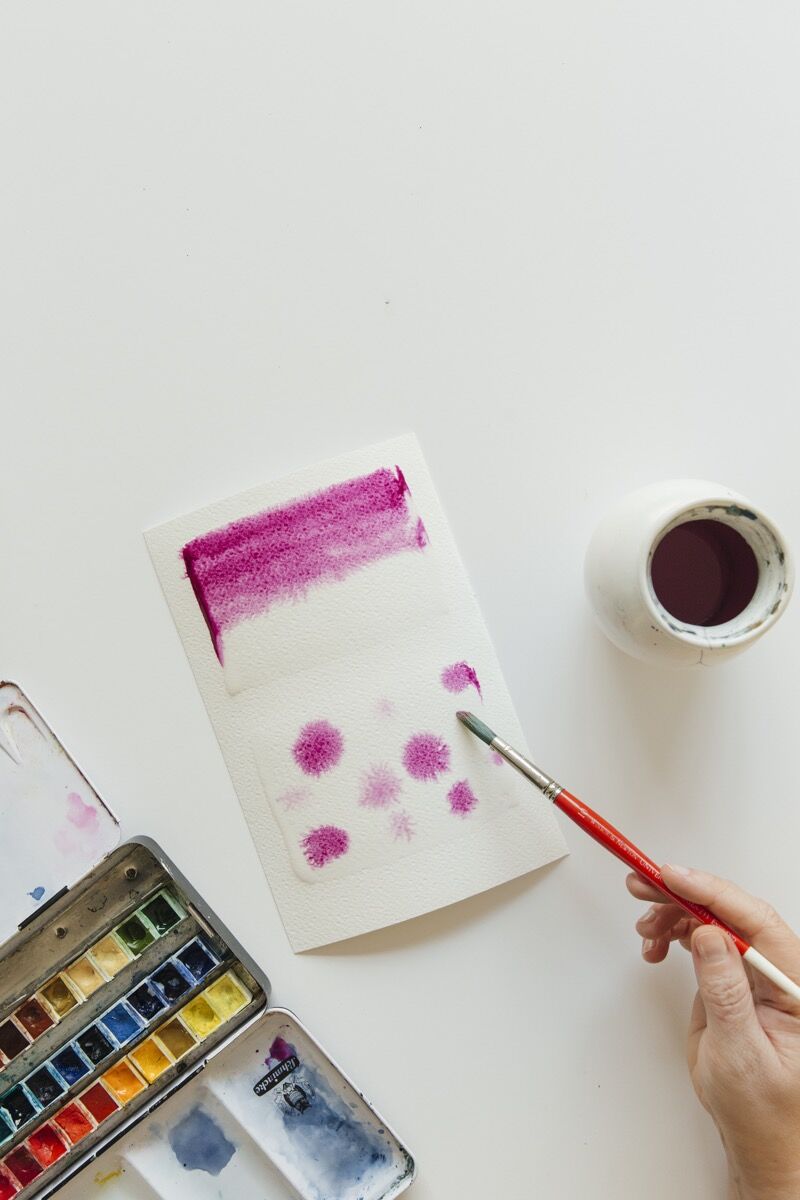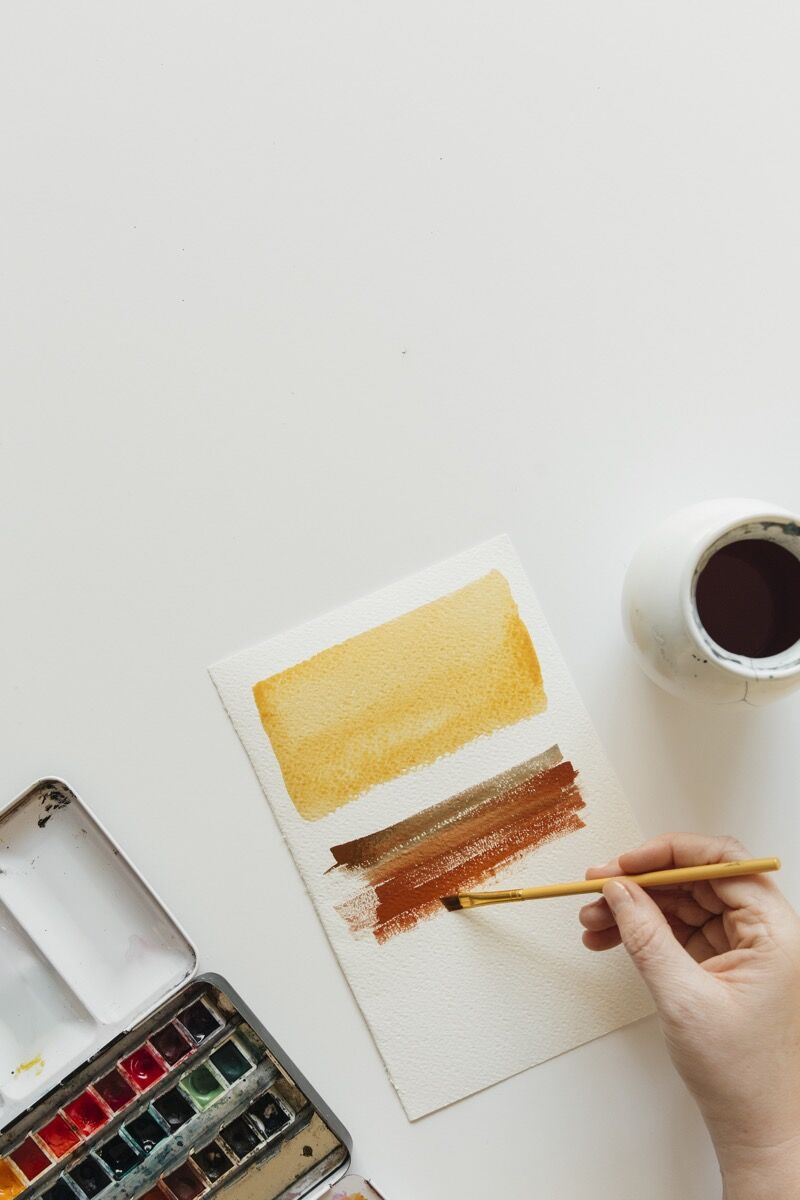5 SIMPLE WATERCOLOR TECHNIQUES
5 SIMPLE WATERCOLOR TECHNIQUES










Creativity
5 Simple Watercolor Techniques for Beginners
Mexico City-based artist Ana Victoria Calderón has taught watercolors through workshops and creative retreats, as well as through online classes via Skillshare, where she’s shared her lessons with over 30,000 students. Below, we share excerpts from her forthcoming book, Creative Watercolor: A Step-by-Step Guide for Beginners (available this December), including five basic activities to help you get started with watercolors.
Watercolor can be intimidating for beginners, and even some experienced artists find it challenging. In fact, throughout my years teaching the medium, I’ve met many talented acrylic and oil painters who have a hard time switching over to watercolor because it just works so differently. With these simple warm-up activities, you’ll begin to understand how watercolor really works, get comfortable with your paints, and hopefully come up with ideas for new creations.
Wet-on-wet

© 2018 Quarto Publishing Group USA Inc.

There are a couple of basic ways to paint with watercolor. The wet-on-wet method is typically used for painting landscapes, simple skies, or soft watercolor washes because the effect gives us a nice flowy look that can be applied in different ways. Basically, we’re adding wet paint to a wet surface. Here’s a simple activity that can help familiarize you with this technique.
1. Start by wetting your brush with plain water and “painting” two rectangles.
2. The rectangles will be hard to see because there’s no pigment, but if you tilt your head a bit, you will be able to see where you have applied the water.
3. Pick up moistened paint from your palette and add color to your wet rectangle. In this image, I’m simply sliding my brush from side to side.
4. In your second rectangle, just add dabs of paint. This activity is great for beginning to gauge the amount of water and paint you prefer to use.
5. Next, your paint has begun to dry. See how different it looks? When painting wet-on-wet, we don’t have much control over how our paint reacts. This is a beautiful aspect of this technique; watercolor dries in mysterious ways.
6. Once the paint has completely dried, you’ll see that it’s changed even more. It’s normal for colors to appear less vibrant once they’ve dried. Interesting textures also appear, which makes wet-on-wet a great technique for adding texture to painted shapes.
Wet-on-dry

© 2018 Quarto Publishing Group USA Inc.

Wet-on-dry is used to achieve more precise and defined shapes. This is the technique I like most, and, in general, most illustration-style watercolors are achieved using wet paint over a dry area.
1. Start with dry paper. Pick up some moistened paint with a large brush and simply begin to paint.
2. The ochre paint I used here is quite watered down. The opacity of your paint will depend on how much water you mix in.
3. You can also try using drier paint. I used the minimum amount of water to get my paint going, and you can see we get a completely different texture, a sketch-like finish.
4. Now, the paint is completely dry. Again, notice how the colors tend to fade and can look quite different at this point.
Building up color

© 2018 Quarto Publishing Group USA Inc.

This activity will help you practice building up color from plain water to a saturated paint mix. We’ll be using just one color to achieve different values, looking to create a seamless effect, popularly known as “ombré.”
1. Start with a dry area of watercolor paper. Drop a small puddle of water into your palette and a dab of concentrated paint right next to it. I used a medium-sized brush and a bit of green tube watercolor.
2. Pick up a bit of water with your brush (no pigment yet) to get you started. Begin painting your strip (it will look transparent on the paper).
3. Add a tiny bit of pigment into your puddle of water; make sure to be mindful of how much paint you are adding. You want this process to be subtle and work up slowly.
4. Continue by painting where you left off with the transparent water.
5. Repeat the process by adding a bit more paint to your initial puddle of water each time. Before picking up more color, remember to rinse and pat your brush on a piece of cloth or paper in between so it’s clean.
6. By the time you reach the end of your strip of paint, your watercolor mix should be quite thick and the paint should appear concentrated and as opaque as it can get.
7. Now you have a nice transition from water to concentrated paint. The goal is for the process to be delicate, with no harsh transitions from one value to the next.
8. Repeat as many times as you wish. Try this activity a few times to experiment with different colors and to begin to feel comfortable building up color.
Creating gradients

© 2018 Quarto Publishing Group USA Inc.

This activity is similar to building up color, but instead of working with plain water and different values of one color, we’ll be working with two colors and slowly transitioning from one to the other. It’s a great technique for painting skies and sunsets.
Be sure to use colors that are close together on the color wheel to create harmony; otherwise, your gradient will appear muddy. I used green and yellow; other good combinations are blue and purple, red and orange, or blue and green.
1. Mix two separate colors side by side. The paint should be neither too diluted nor too concentrated; aim for a 50/50 ratio of water to paint for each color.
2. Start painting your strip of color using pure yellow paint.
3. Clean your brush. Pick up just a little bit of green paint and mix it into your yellow mixture.
4. Pick up where you left off on your first brushstrokes. The transition from yellow to a slightly greener yellow should be soft and subtle. Try to avoid harsh changes in tone so the gradient doesn’t look choppy.
5. Little by little, keep adding a bit more green to your original yellow mix. In this exercise, the real work happens in the palette.
6. By the end of this paint strip, your original mix should completely transformed into pure green and you’ll have a beautiful gradient of color.
7. Try this as many times as you feel necessary and experiment with different color tones. You might get ideas for paintings by trying out different colors.
Getting Precise

© 2018 Quarto Publishing Group USA Inc.

This activity is a simple way to practice painting around edges of shapes in a controlled way.
1. Paint simple shapes around your dry piece of watercolor paper. I chose circles, stars, and a moon, but you can choose any simple shape you like. Triangles, diamonds, hearts, and squares can work, too.
2. Using a different color, begin painting around these shapes. You’ll want to use two different sized brushes here: one for smaller more detailed areas that are tough to reach, and a larger round brush when you’re filling out larger areas.
3. Make sure to prepare enough blue paint (about 50/50 water to watercolor). For a better flow, keep the blue area of your painting moist, so you can pick up where you left off each time.
4. Get really close to each shape. The goal is to paint as close as you can without actually touching the first shape. You will have very fine white lines between the shapes and the background.
5. Another way to practice is by painting just inside the edge of your paper, creating a border. In addition to working on brush control, you will start to notice beautiful watercolor textures appearing. This depends on how much water you use, the type of paper, and how fast you move.
6. Repeat this simple practice exercise as many times as you feel necessary. It’s a great way to get into the illustration-style watercolor groove.
Creative Watercolor: A Step-by-Step Guide for Beginners by Ana Victoria Calderon. Publication Date: December 11, 2018. © 2018 Quarto Publishing Group USA Inc.
Ana Victoria Calderón is a Mexican-American watercolor artist and teacher.

Comments
Post a Comment